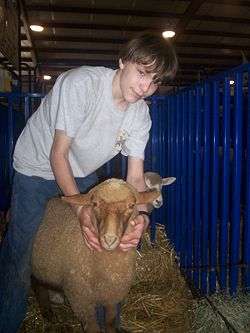Tunis sheep

The Tunis (also known as Tunisian Barbary) is a medium-sized, fat-tailed sheep that is naturally hornless (polled) with cream-colored wool and a cinnamon-red face and legs.[1] This breed is raised primarily for meat.[2]
Characteristics
The head is slender with pendulous ears. Tunis lambs are robust at birth and are warmed by a double coat, which is a darker shade of red on the surface. White spots on the top of the head and tip of the tail are common. The creamy white fleece appears as the lamb matures. Tunis wool is lustrous and long-stapled, four to six inches. Tunis ewes are heavy milkers—heavy enough that some are used in sheep dairies. Twins are more common than not, and Tunis are known to breed out of season, which makes them valuable for fall lamb production. Tunis also are known for disease resistance and the ability to tolerate both warm and cold climates. The meat from the Tunis sheep is tender and flavorful without having a strong mutton taste.
At birth, Tunis lambs weigh 7 to 12 lb (3 to 5 kg). Mature rams in breeding condition weigh between 175 and 225 lb (80 and 100 kg) and measure 28 to 30 in (71 to 76 cm) at the withers. Mature ewes should be 25 to 50 lb (10 to 20 kg) lighter and 2 to 4 in (5 to 10 cm) shorter.[3]
History
The Tunis is one of the oldest breeds of sheep, having descended from ancient fat-tailed sheep referred to in The Bible. As the name indicates, the Tunis originated in Tunisia on the Northern coast of Africa. The earliest documented importation to the U.S.A. occurred in 1799, a gift from the ruler of Tunisia and entrusted to the care of Judge Richard Peters of Pennsylvania. One of the largest advocates of the Tunis breed was Thomas Jefferson, who owned a fairly large flock.[4]
The Tunis popularity spread quickly and flocks were started primarily on the East coast and New England, where many remain today. Because of their flavorful meat most of the Southern flocks were wiped out during the Civil War.
The National Tunis Sheep Registry, Inc. has experienced continuous growth in registrations and transfers, moving from the threatened status to the watch list of the American Livestock Breeds Conservancy (ALBC) Conservation Priority List.
References
- ↑ "Tunis Breed Information". The National Tunis Sheep Registry, Inc. June 4, 2008. Retrieved 2008-05-05.
- ↑ "Tunisian Barbarin/Tunisia". Breed Data Sheet. Domestic Animal Diversity Information System. Retrieved 2009-09-09.
- ↑ "Tunis". Breeds of Livestock. Oklahoma State University, Dept. of Animal Science. Retrieved 2015-07-19.
- ↑ "Tunis". Sheep Breeds - St-U. Sheep101.info. Retrieved 2009-05-04.